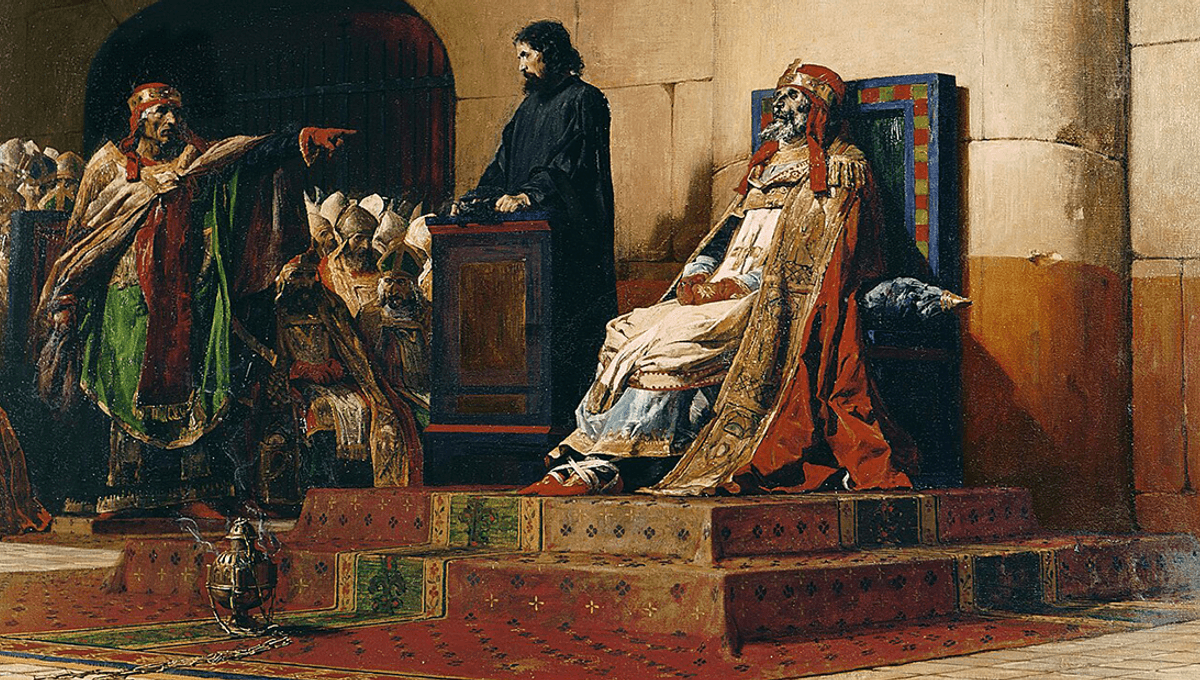
After the last few years and the hit movie Conclave, you probably have a rough idea of how the Catholic church deals with the death of a Pope and the process afterwards. But the process has evolved somewhat, as highlighted by events in 897 CE, when a newly appointed Pope dug up his predecessor’s corpse and put it on trial for crimes, before cutting off its fingers and hurling it into the Tiber River.
Formosus was elected as pope on October 6, 891 CE, during a particularly turbulent time for the papacy, and political instability in Italy. During what is sometimes referred to as the “Iron age of the papacy”, factions vied for control of the papacy and all the power that brought.
“The Chair of St. Peter became the prize of tyrants and brigands and a throne fouled by fierce tides of crime and licentiousness [and] the papacy became the possession of great Roman families, a ticket to local dominance for which men were prepared to rape, murder, and steal,” historian Eamon Duffy explains in Saints and Sinners: A History of the Popes.
“All real power was at this time in the hands of the great families who, through their connection with the local militia, had become practically a feudal aristocracy. These families were all jealous of one another, and were perpetually fighting for supremacy. The one aim of each party, pursued by every resource of violence and intrigue, was to get control of the Chair of St. Peter. Its occupant must be one of theirs at all costs.”
As coveted as the position was, it didn’t do great things for your life expectancy. In fact, it was pretty much a fast lane to exile or sainthood.
“During the iron age of the papacy pope succeeded pope with bewildering rapidity,” Donald E. Wilkes Jr, former professor of law at the University of Georgia School of Law, explains in an article. “In the 94 years from 872 through 965 there were 24 popes; and during the nine years between 896 and 904 there were no less than nine popes. (By contrast, there was a total of only nine popes in the entire 20th century, and one of them, John Paul I, reigned only 33 days.)”
Formosus was very much involved in politics and the game of whack-a-pope, and had been forced to flee to France after the candidate for Holy Roman Emperor he supported lost out to Charles the Bald. (Side note, but it shows an impressive lack of other features to be left with the suffix “the bald”). But after returning to Italy and being restored to his diocese, courtesy of Pope Marinus I, Formosus was elected pope on October 6, 891, the start of a fairly short stint as head of the Catholic church.
Formosus worked against Holy Roman co-emperors Guy II and his son Lambert, encouraging King Arnulf of the East Franks to invade Italy, before crowning him as emperor in 896 CE. Arnulf was forced to return to Germany due to ailing health, and Formosus died shortly after that in April. But we’re only getting to the beginning of why he is remembered so well, amongst the many popes of the time.
In January 897 CE, Formosus’s successor Pope Stephen VI dug up his corpse from St. Peter’s Basilica, in order to put him on trial. His corpse, which was likely not in spectacular condition all those months later, was dressed in ecclesiastical robes before being propped up on the papal throne for questioning, with a deacon appointed to advocate on behalf of the cadaver.
Disappointingly, no transcript of the trial was recorded, though we know that the corpse was accused of perjury, coveting the papacy, and violating church canons when he was elected pope. The teenage deacon chosen to represent the dead pope timidly did his job, while the living pope yelled accusations at the cadaver.
“The trial was completely dominated by Stephen VII, who overawed the assemblage with his frenzied tirades,” Wilkes Jr explains. “While the frightened clergy silently watched in horror, Stephen VII screamed and raved, hurling insults at and mocking the rotting corpse. Occasionally, when the furious torrent of execrations and maledictions would die down momentarily, the deacon would stammer out a few words weakly denying the charges. When the grotesque farce concluded, Formosus was convicted on all counts by the court.”
Following the (very fair) trial, Stephen VI ordered that three of Formosus’s fingers used for blessings be removed, before stripping him again and placing his body in rags. His body was then thrown into the Tiber River, reserved for infamous criminals, though it wasn’t there for long.
“When he was afterwards found by fishermen and carried to the Church of the blessed Prince of the Apostles, certain images of the saints, with veneration, saluted him, placed in his coffin; for this I have very often heard from most religious men of the city of Rome,” a contemporary chronicler, Liutprand of Cremona, wrote.
Formosus was returned to his burial place after his unusual post-death trial and swim. Unfortunately for Stephen VI, he didn’t get much chance to dwell on his court win. His weird reign did not last much longer, as he was imprisoned before being strangled to death. His own corpse was not subject to any criminal proceedings.
Source Link: Cadaver Synod: In 897 CE, The Catholic Church Put A Pope's Corpse On Trial